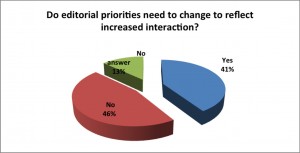Traditional news editorial still matters
Accuracy and ethics make good news
While people are concerned with the future of news, and are embracing digital media, traditional journalists will still have to be gatekeepers and leaders of this new era.
The journalism business now encourages user-generated content with much audience interactivity in the local and editorial news as well as on blogs. Several questions emerge about how this is changing the industry.
According to Francine Hardaway, “Today the media-driven by blogs-is assailed on all sides, by the crushing economics of their business, dishonest sources, inhuman deadlines, page view quotas, inaccurate information, greedy publishers, poor training, the demands of the audience, and so much more.”
However, it is those of us who care about the possible decline of good journalism that will help to fix what is becoming “indistinguishable” between real and fake journalism. When bloggers deliberately publish inaccuracies, they later correct them, just to produce even more page views, writes Hardaway.
Hardaway writes about the digital writers who lure readers in for clicks. And “how blogs-even the most trusted ones-invent stories or publish rumors, just to get a post up and some page views, and then wait to see if anyone comments.”
But she also writes that the future of news is promising because there are journalism schools like ASU’s Cronkite School of Journalism that is doing a good job at preparing students for the future.
“So Cronkite is inadvertently turning out students who are trained in ethics, quality and accuracy into a quagmire of media manipulation…,” writes Hardaway. She promises to be a part of the faculty that will help to train these students.
Meanwhile, we have learned that this evolution in the news will be ongoing. The digital era will not be the last stage of the news cycle. Therefore, some are wondering how far will the interactive nature of news go.
Writers, Penny O’Donnell, senior lecturer in International Media and Journalism at University of Sydney, and David C. McKnight, associate professor of Journalism and Media Research at the Centre at University of New South Wales, ask “whether editorial priorities had changed in response to this greater interactivity with readers…” They report that 46 per cent said that they did not, while 41 per cent “accepted” that they had.
We have seen where even traditional journalists have accepted the blurring of traditional boundaries between audience and journalists. Some of us consider the interactivity very democratic. But we are reminded that traditional journalists need to be the leaders of this evolution.
O’Donnell and McKnight write that, “there are persistent doubts as to what journalism will look like when journalist put down their old mantle of ‘gatekeeper’ and instead take up a new role as ‘facilitator’ or ‘curator’ of multi-participant news conversations.”
According to the writers, “professional journalist must maintain strict control over editing and the output.”
Susan Currie Sivek writes about the message Richard Gingras, head of news products at Google, conveyed to the Association for Education in Journalism and Mass Communication, (AEJMC) in Chicago.
She notes that he encouraged educators to take the lead in shaping the changes that are happening in the media through their curricula. “Educators will also have to take risks in their teaching and advising to help students achieve the skill set and perspective Gingras recommends – and perhaps, to bring about a ‘renaissance’ in the field.”
